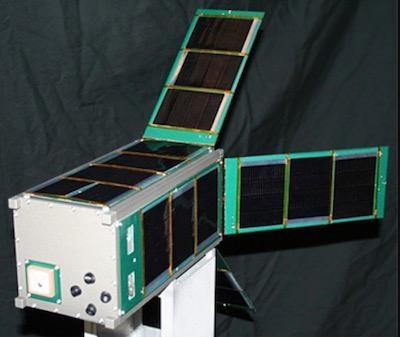Modular, Lightweight And Highly Efficient Solar Cells Enabled Rapid Development And Deployment Of FastBus Small Satellite Platform
A successful CubeSat mission by Twiggs Space Lab, LLC (TSL), NearSpace Launch, Inc. (NSL) and their launch logistics partner, NanoRacks LLC (NanoRacks), was powered by Alta Devices solar. The Asgardia-1 satellite was based on NSL’s FastBus platform and powered by approximately 24 watts of Alta solar cells. Launched in November 2017 on an Orbital ATK (now Northrop Grumman) cargo resupply mission, the 2U-size FastBus was inserted into a 475 km low earth orbit in December 2017 via the NanoRacks External Cygnus Deployer. The 2U satellite carried a payload which included a solid-state memory experiment and particle detectors used to determine the actual effects of on-orbit radiation.

TSL, NSL and NanoRacks are at the forefront of small satellite innovation and are pioneering new, disruptive models of satellites that are much smaller, simpler, and more affordable. Their mission is to broaden access to space for educational as well as commercial participants. They selected Alta Devices solar technology due to its unique modular, lightweight, and high efficiency characteristics.
"Our goal is to inspire future generations of engineers and scientists through innovation in the field of space. Alta Devices technology is easy to integrate, and its modular form factor is well-suited to the standardized dimensions of CubeSats," said Bob Twiggs, founder of TSL. "Our team is excited about the potential to innovate and rapidly prototype using this technology”.
"With the FastBus, we aim to provide a reliable, affordable, and quick-turn CubeSat platform built on our heritage of communication and bus technologies. We are very excited to be using Alta Devices technology to serve the needs of our stakeholders,” said Dr. Hank Voss, founder of NearSpace Launch.
"At Nanoracks, we’re focused on lowering the barriers of entry to space. We see adoption of innovative solar and bus technologies as another critical piece of the puzzle in making space exploration accessible to entrepreneurs, scientists, students, corporations, and space researchers around the world,” said NanoRacks CEO, Jeffrey Manber. "Any component that is more robust, withstands the launch loads, and maintains a clean ride-share environment is going to make things easier for everyone on a practical and regulatory perspective. The Alta solar cells came through with flying colors on the Asgardia-1 satellites.”
CubeSats (satellites weighing less than 15kg) were originally developed for university students to participate in space research. The standard has now been adopted worldwide and has helped to ignite a small satellite revolution. Typically placed into low-earth orbits, they often have standardized or off-the-shelf components and have facilitated more affordable and easier access to space. CubeSats are driving new industries via the explosion of big data accessible from space.
All satellites need solar cells to generate electrical power. Until now, no commercial solar technologies could match the improvement in cost, weight, and ease of use that other components of small satellite technology have achieved: solar cells are traditionally expensive, fragile, rigid, and difficult to encapsulate and robustly attach to spacecraft.
Alta Devices solar cells overcome these challenges because they are flexible, easy to encapsulate and mount, and provide high power conversion efficiencies. For example, Alta Devices cells can be mounted to low-mass deployable structures including coiled carbon fiber booms, flat-packed, polymer-based accordioned arrays, even inflatable structures, allowing creative design approaches to maximizing onboard solar power. Alta Devices is empowering autonomy, as its cells provide a new level of mechanical and design flexibility for the small satellite industry.
“Innovation in solar is essential to the continued evolution of small satellite technology. The industry has seen disruptive change in every technology area except in solar cells," said Jian Ding, CEO of Alta Devices. "Solar cells were expensive, challenging to integrate, and hard to procure, until now. The success of the FastBus mission provides another data point validating our technology and further cements our commitment to our partners as they plan their upcoming launches.”
(Image provided with Alta Devices news release)
 ANN's Daily Aero-Linx (05.02.24)
ANN's Daily Aero-Linx (05.02.24) ANN's Daily Aero-Term (05.02.24): Touchdown Zone Lighting
ANN's Daily Aero-Term (05.02.24): Touchdown Zone Lighting Aero-News: Quote of the Day (05.02.24)
Aero-News: Quote of the Day (05.02.24) ANN FAQ: Contributing To Aero-TV
ANN FAQ: Contributing To Aero-TV NTSB Final Report: Cirrus Design Corp SR20
NTSB Final Report: Cirrus Design Corp SR20



